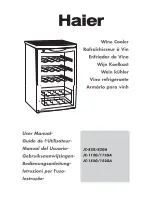
10
PART VII. REMOVING THE ROLLING SHELF
To remove a rolling shelf:
1. Remove all bottles
2. Pull the shelf out as far as possible
3. Push the side lever downward (as illustrated below)
4. Remove
the
shelf
PART VIII.
CARE AND MAINTENANCE
¾
Cleaning Your Wine Cellar.
z
Turn off the power, unplug the appliance, and remove all items including all shelves.
z
Wash the inside surfaces with warm water and baking soda solution. The solution should be about 2 tablespoons of
baking soda with a quart of water.
z
Wash the shelves with a mild detergent solution.
z
Wring excess water out of the sponge or cloth when cleaning area of the controls, or any electrical parts.
z
Wash the outside cabinet with warm water and mild liquid detergent. Rinse well and wipe dry with a clean soft cloth.
z
Dust the front grill and back of the unit twice yearly. Make sure the power is off before cleaning.
z
It is recommended to clean the unit completely inside and out once a year to maximize the longevity of the wine
cellar.
¾
Power Failure
z
Most power failures are corrected within a few hours and should not affect the temperature of your appliance if you
minimize the number of times the door is opened. If the power is going to be off for a longer period of time, you need
to take the proper steps to protect your contents.
¾
Vacation time
z
Short vacations: You may
leave the Wine Cellar operating during vacations of less than three weeks.
z
Long vacations:
If the appliance will not be used for several months, remove all items and turn off the appliance.
Clean and dry the interior thoroughly. To prevent mold growth, leave the door open slightly, blocking it open if
necessary.






























